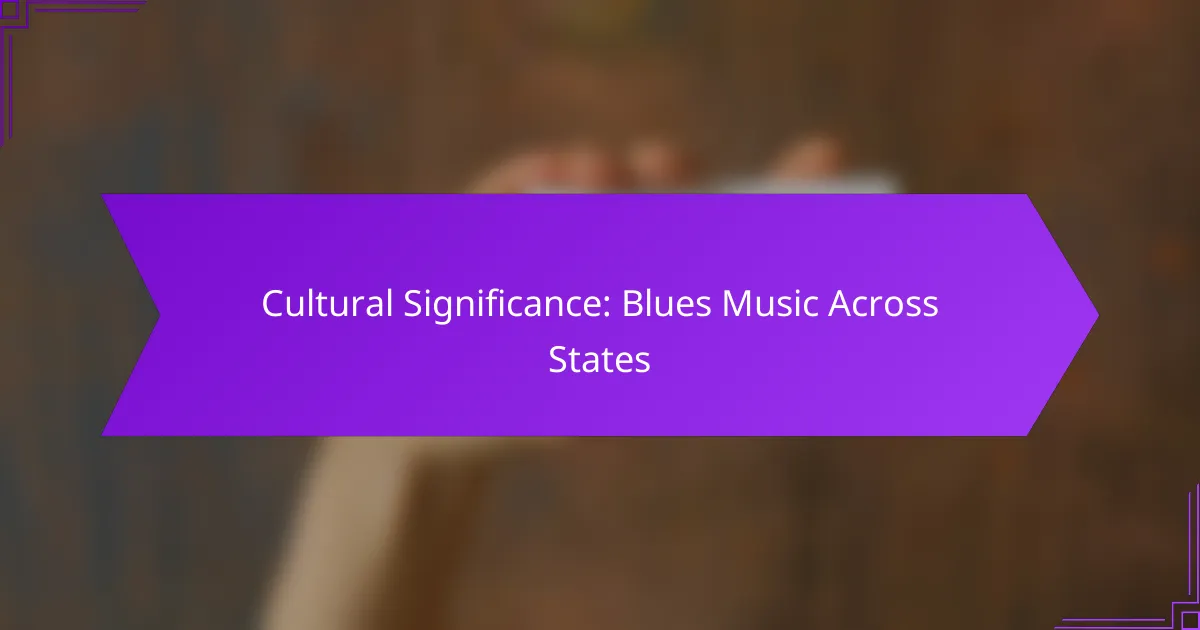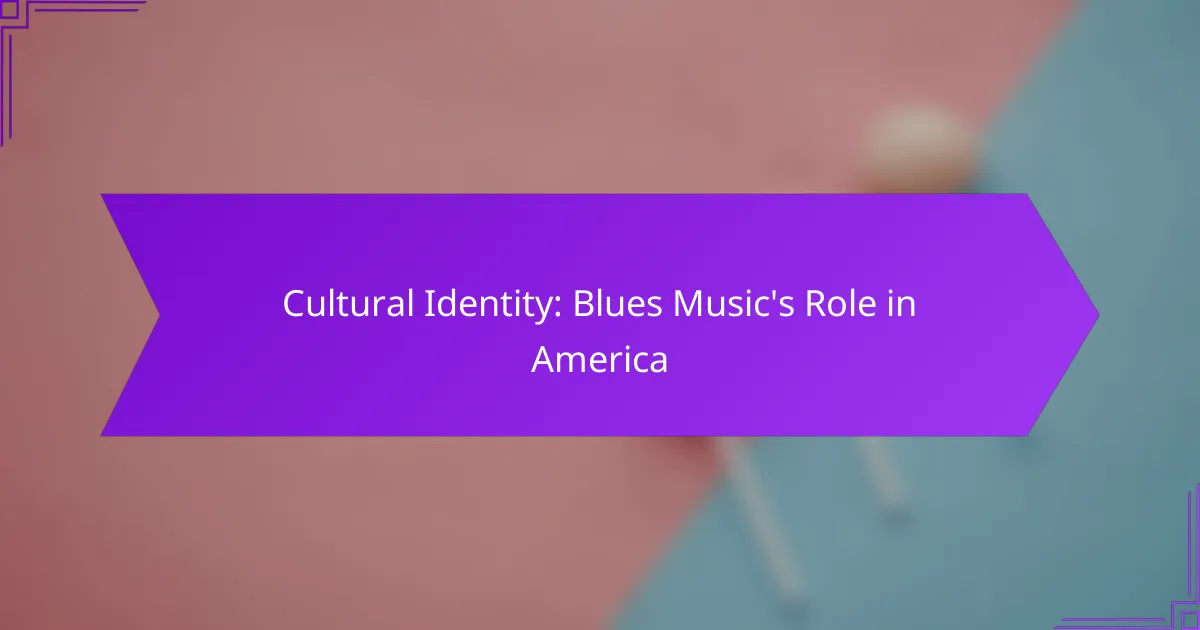Blues music serves as a vital cultural touchstone across the United States, reflecting the unique histories and communities of different regions. From the deep roots of Mississippi’s Delta blues to the electrifying sounds of Chicago and the diverse influences found in Texas, each state contributes to the rich tapestry of this genre. Through its powerful storytelling and emotional depth, blues music fosters connections to heritage and identity, resonating with audiences nationwide.
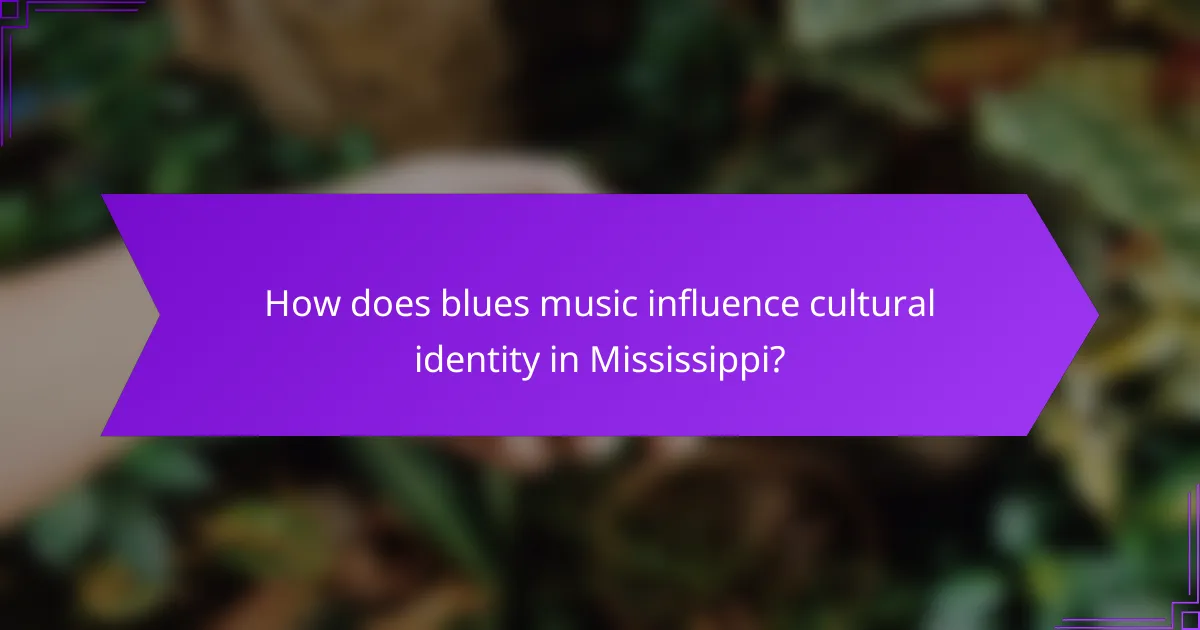
How does blues music influence cultural identity in Mississippi?
Blues music plays a crucial role in shaping cultural identity in Mississippi by reflecting the state’s rich history and diverse communities. It serves as a powerful medium for storytelling, connecting individuals to their heritage and fostering a sense of belonging.
Historical roots of blues in Mississippi
The origins of blues music in Mississippi can be traced back to the late 19th and early 20th centuries, emerging from African American communities. Influenced by spirituals, work songs, and folk traditions, blues became a form of expression for the struggles and experiences of these communities.
Key figures, such as B.B. King and Muddy Waters, helped popularize the genre, with their music often reflecting the social and economic challenges faced by African Americans in the South. The Mississippi Delta is often regarded as the birthplace of the blues, with its unique cultural landscape contributing to the genre’s development.
Impact on local communities
Blues music fosters community cohesion in Mississippi by bringing people together through festivals, live performances, and local gatherings. These events not only celebrate the music but also promote local artists and businesses, enhancing the cultural fabric of the area.
Moreover, blues serves as a vehicle for cultural preservation, allowing younger generations to connect with their roots. Music education programs and workshops often focus on blues, ensuring that this vital part of Mississippi’s heritage continues to thrive and evolve.

What are the key characteristics of Chicago blues?
Chicago blues is characterized by its use of electric instruments, a strong rhythmic foundation, and themes that reflect urban life. This genre evolved from traditional Delta blues, incorporating a more amplified sound and complex arrangements to resonate with city audiences.
Electric guitar prominence
The electric guitar is a defining feature of Chicago blues, often taking center stage in performances. Artists like Muddy Waters and Buddy Guy popularized the use of electric guitars, which allowed for greater expression and volume compared to acoustic instruments.
In Chicago blues, guitar solos are typically expressive, featuring techniques such as bending notes and using distortion. This creates a raw, emotional sound that enhances the storytelling aspect of the music.
Urban storytelling themes
Chicago blues often explores themes of hardship, love, and resilience, reflecting the experiences of urban life. Lyrics frequently address struggles with relationships, work, and the challenges of city living, resonating with listeners who share similar experiences.
Storytelling in Chicago blues is not just about the lyrics; the music itself conveys emotion and narrative. The combination of soulful vocals and dynamic instrumentation creates a powerful medium for expressing the complexities of life in the city.
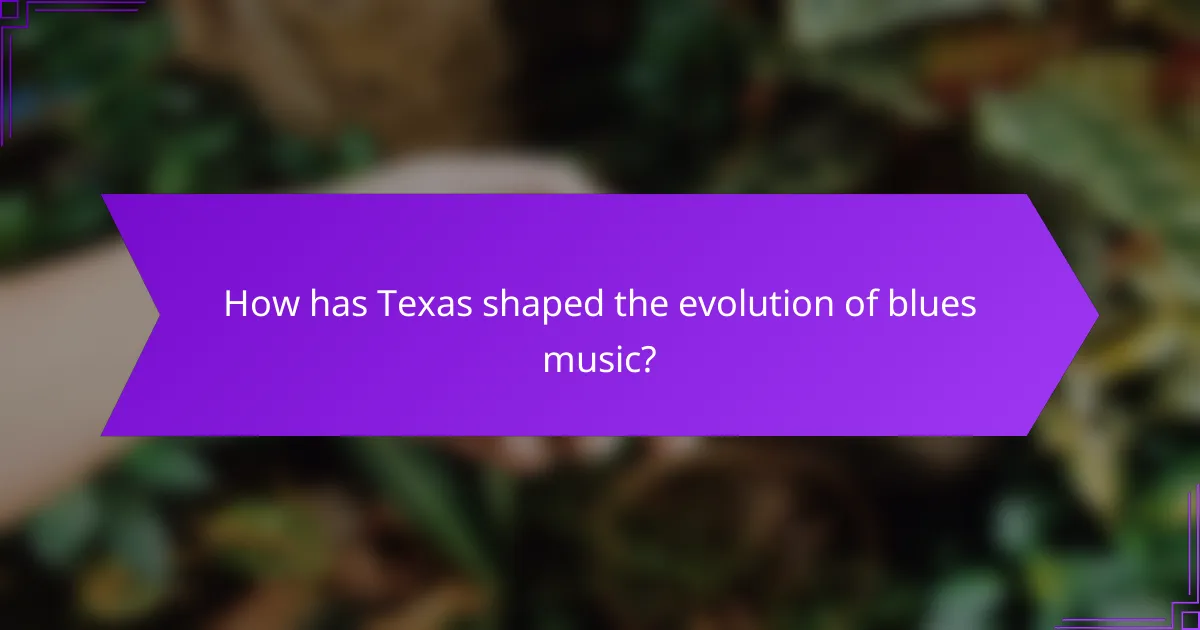
How has Texas shaped the evolution of blues music?
Texas has played a crucial role in the evolution of blues music by blending various musical styles and fostering a unique sound. The state’s rich cultural diversity and historical significance have contributed to the development of distinct subgenres within the blues, making it a vital hub for artists and fans alike.
Integration of country influences
Texas blues is characterized by its integration of country music influences, which has created a distinctive sound that sets it apart from other blues styles. This fusion often features elements like storytelling lyrics and the use of acoustic instruments, such as the guitar and fiddle, which are staples in both genres.
Many Texas blues musicians incorporate country rhythms and melodies, resulting in a sound that appeals to a broader audience. This blend has led to the emergence of subgenres like Texas country blues, which showcases the interplay between blues and country music traditions.
Notable Texas blues artists
Several influential blues artists have emerged from Texas, each contributing to the genre’s evolution. Notable figures include Stevie Ray Vaughan, whose electrifying guitar work and passionate performances helped revive interest in blues music during the 1980s. His unique style combined traditional blues with rock elements, attracting a diverse fan base.
Other significant artists include Lightnin’ Hopkins and T-Bone Walker, who were instrumental in shaping the Texas blues sound. Their innovative approaches to guitar playing and songwriting have left a lasting impact on both blues and rock music, inspiring countless musicians across generations.
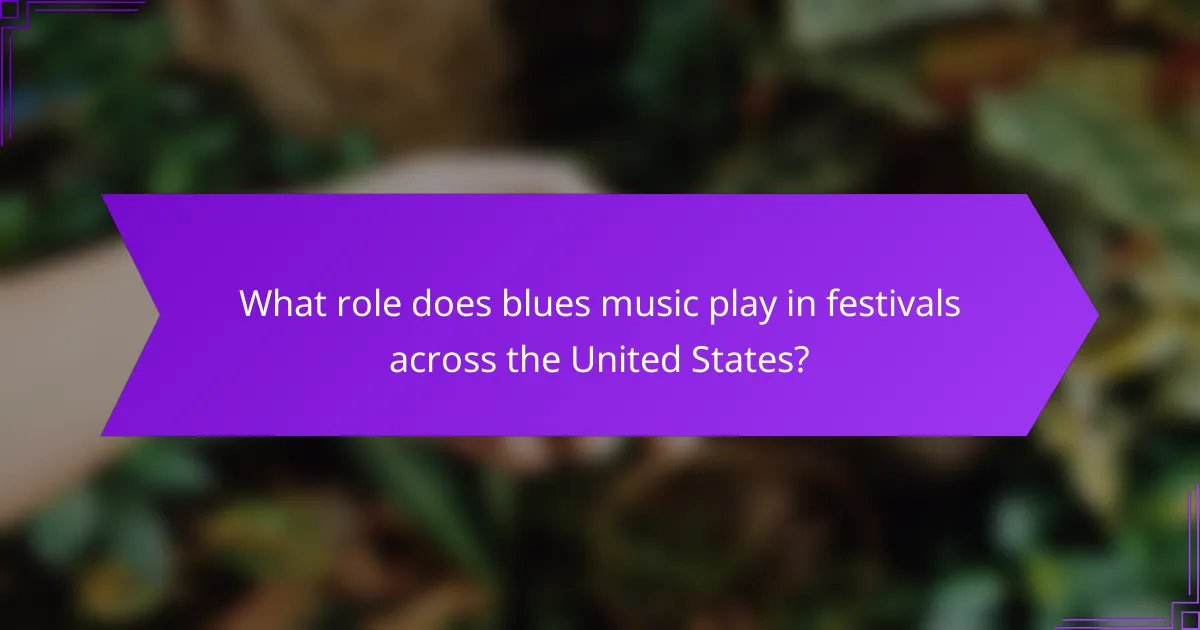
What role does blues music play in festivals across the United States?
Blues music serves as a vital cultural element at festivals across the United States, celebrating its rich history and influence. These events not only showcase performances but also foster community engagement and economic growth.
Major blues festivals in the U.S.
Some of the most notable blues festivals include the Chicago Blues Festival, the King Biscuit Blues Festival in Arkansas, and the New Orleans Jazz & Heritage Festival. Each of these events attracts thousands of attendees, featuring both legendary artists and emerging talents.
These festivals often span several days and include a variety of activities such as workshops, jam sessions, and food vendors, creating an immersive experience for attendees. They highlight the diverse styles within the blues genre, from Delta blues to Chicago blues.
Economic impact on local economies
Blues festivals significantly contribute to local economies by attracting tourists and generating revenue for businesses. Estimates suggest that festivals can bring in millions of dollars, benefiting hotels, restaurants, and local artisans.
Additionally, these events create temporary jobs and promote long-term tourism, as attendees often return to explore the local culture and music scene. Local governments may also see increased tax revenues from the influx of visitors during festival weekends.

How can you experience authentic blues music in New Orleans?
To experience authentic blues music in New Orleans, immerse yourself in the vibrant local scene by visiting renowned venues and discovering talented artists. The city is a hub for blues, offering live performances that capture the genre’s rich history and cultural significance.
Live music venues
New Orleans boasts numerous live music venues where blues thrives. Iconic spots like the House of Blues and Tipitina’s regularly host performances by both established and emerging artists. Smaller venues, such as the Blue Nile and the Spotted Cat Music Club, provide an intimate setting to enjoy raw, authentic blues.
When planning your visit, check the venue schedules as many host jam sessions and open mic nights, giving you a chance to see local talent up close. Cover charges can vary, but expect to pay around $10 to $20 for most shows.
Local blues artists to watch
New Orleans is home to a wealth of talented blues artists. Musicians like Walter “Wolfman” Washington and Jon Cleary are known for their electrifying performances and unique styles that blend blues with other genres. Keep an eye on up-and-coming artists like the NOLA Blues Band, who are making waves in the local scene.
To discover new talent, consider attending local festivals such as the New Orleans Jazz & Heritage Festival, where many blues artists perform. This event showcases a diverse range of musicians and offers a great opportunity to experience the city’s vibrant blues culture.
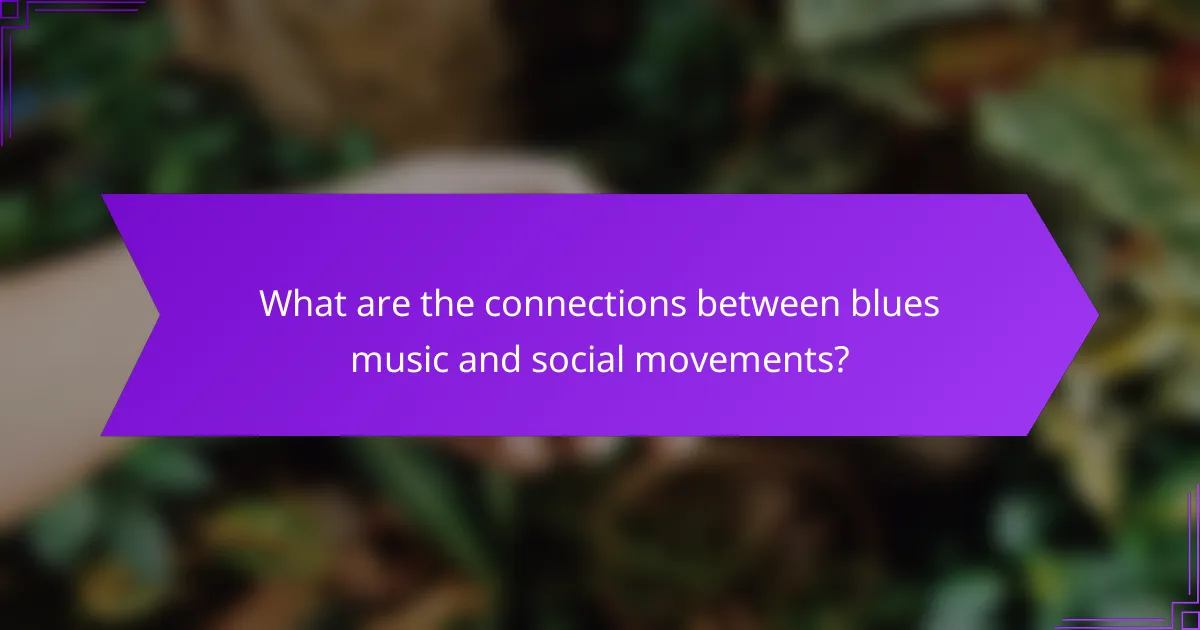
What are the connections between blues music and social movements?
Blues music has deep connections with social movements, particularly in its role as a form of expression for marginalized communities. It has served as a powerful medium for voicing struggles, injustices, and aspirations, influencing various social change efforts throughout history.
Blues as a voice for civil rights
Blues music emerged from the African American experience in the South, often reflecting the harsh realities of life under systemic oppression. Artists like B.B. King and Muddy Waters used their music to highlight social injustices, resonating with the civil rights movement of the 1960s. Songs such as “Strange Fruit” by Billie Holiday poignantly addressed racial violence and discrimination.
The genre became a rallying cry for activists, who recognized its ability to convey deep emotional truths and unite people around a common cause. Blues festivals and events often serve as platforms for discussions on civil rights, linking the music’s legacy with ongoing social justice efforts.
Influence on modern protest music
Blues has significantly influenced modern protest music, inspiring genres like rock, hip-hop, and folk. Contemporary artists such as Bruce Springsteen and Kendrick Lamar draw on blues themes to address social issues, using the genre’s emotive power to engage listeners in conversations about inequality and injustice. The raw, honest storytelling in blues continues to resonate with new generations of musicians.
Moreover, the structure and style of blues music, characterized by its call-and-response patterns, have become foundational elements in protest songs. This enduring influence highlights how blues music not only reflects social movements but also actively shapes the narrative of resistance and change in today’s society.

How does blues music vary across different states?
Blues music exhibits distinct variations across states, influenced by local culture, history, and musical traditions. Each region contributes unique sounds and styles, reflecting the diverse experiences of its communities.
Regional styles and sounds
Blues music can be categorized into several regional styles, including Delta, Chicago, and Texas blues. Delta blues, originating in Mississippi, is characterized by its raw, acoustic sound, often featuring slide guitar and heartfelt lyrics. In contrast, Chicago blues incorporates electric instruments and a more urban feel, showcasing a blend of jazz and rhythm and blues.
Texas blues, known for its upbeat tempo and incorporation of swing elements, often features guitarists who emphasize improvisation and showmanship. These regional differences highlight how local influences shape the music’s overall sound and performance style.
State-specific blues legends
Each state boasts its own blues legends who have significantly impacted the genre. Mississippi is home to iconic figures like Robert Johnson, whose haunting melodies and storytelling set the foundation for modern blues. Additionally, B.B. King, often referred to as the “King of Blues,” hails from Mississippi and is celebrated for his expressive guitar playing and vocal style.
In Chicago, Muddy Waters emerged as a pivotal figure, helping to popularize electric blues and influencing countless musicians. Texas has its own legends, such as Stevie Ray Vaughan, known for his virtuosic guitar skills and fusion of blues with rock elements. These artists not only shaped their respective states’ blues scenes but also left a lasting legacy on the genre as a whole.
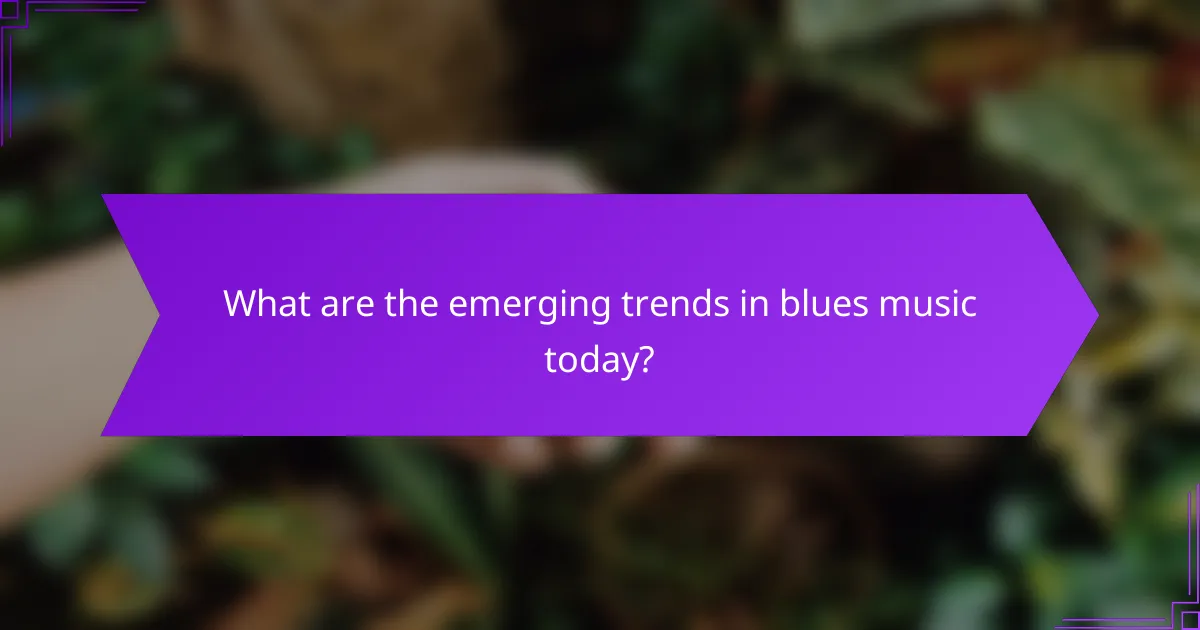
What are the emerging trends in blues music today?
Emerging trends in blues music today include a blend of traditional elements with modern influences, creating a dynamic sound that appeals to diverse audiences. Artists are increasingly experimenting with technology and collaborating across genres, leading to innovative interpretations of the blues.
Fusion with other genres
Fusion of blues with other genres is becoming increasingly popular, as artists seek to reach broader audiences and infuse new energy into their music. Common genres that blend with blues include rock, jazz, and hip-hop, allowing for a rich tapestry of sounds and styles.
For instance, contemporary blues musicians often incorporate electronic elements or collaborate with hip-hop artists, resulting in a fresh take on traditional blues themes. This fusion not only revitalizes the genre but also attracts younger listeners who may not have engaged with classic blues.
When exploring fusion, musicians should consider maintaining the emotional depth of blues while experimenting with new rhythms and instrumentation. This balance can help preserve the genre’s roots while appealing to modern tastes, ensuring its continued relevance in today’s music scene.
